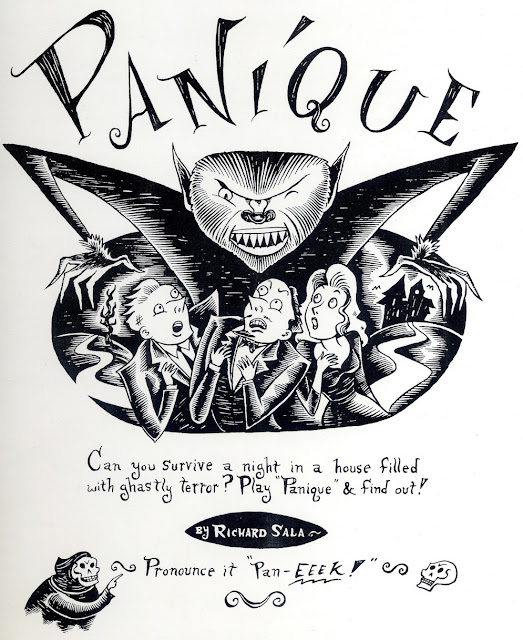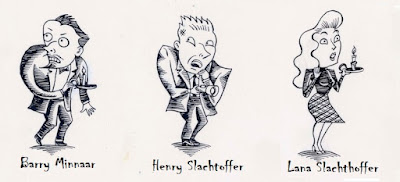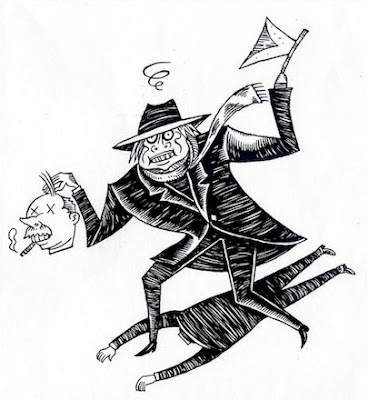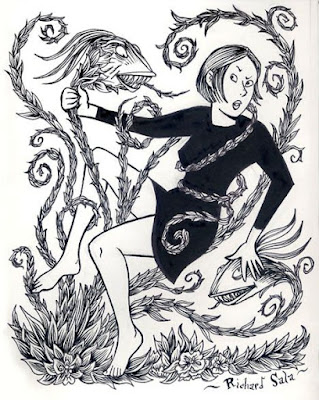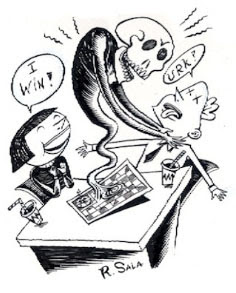These appear to be a set of well-used drumsticks carved from oak wood. When they are checked for magical aura (though the use of spells, devices, or abilities), they radiate faint abjuration magic or a divine nature.
Powers: Reported to have been touched by the Christ Child and his mother days after his brith, these drumsticks are a single artifact in two parts. When separated, they have no apparent magical function. Each stick radiates magic, is seemingly indestructible, and can used as improvised piercing weapon that deals 1d2 points of damage. While the item can be considered an enchanted weapon at +1 level, it does not grant bonuses to hit or damage.
When the sticks are carried by the same person, he or she gains a +1 bonus to all saving throws. He or she gains a +6 bonus to all Perform (drums) skill checks when using the Drumsticks of Bethlehem. Once per day, the character may designate a target and cast a sleep spell upon it while playing the drums using the drumsticks.
Drawbacks: Whenever carrying the Drumsticks of Bethlehem, the character must roll a Will save (DC18) whenever idle, or near a cute baby. If the save fails, he or she is gripped by an urge to start using the drumsticks on any available surface. If there is a snare drum available, the save is against DC24).
Destruction: The Drumsticks of Bethlehem can only be destroyed by being tossed into the fires of Hell itself.
The Little Drummer Boy's Drum (aka The Drum of Bethlehem)
This item appears to all inspection to be a well-used and extremely well-made tabor-style snare drum. It does not appear to be magical, but attempts to break or destroy it fail. The word "Bethlehem" is painted onto the drum's head in Aramaic script.
Powers: When a character with 5 or more ranks in Perform (drum) plays it, he or she gains a +10 bonus to any related skill checks. If the performance is done using the Little Drummer Boy's Drumsticks, the bonus increases to +15. Additionally, the performer can designate one target within 60 feet to be subjected to an affect similar to a sleep spell. The target receives a Will save equal to the character's Perform (drum) skill check. If the saving throw fails, the target falls into a magical slumber that lasts a number of hours equal to the character's total Perform (drum) skill. (The first power--the bonus to the Peform skill--is evident to both the user and those witnessing the performance, The second power is only evident if an identify spell, or similar means, is used to examine the drum while it is being played with the Little Drummer Boy's Drumsticks.
Drawback: None.
Method of Destruction: The Little Drummer Boy's Drum loses all enchantment if its head is pierced with one of the Little Drummer Boy's Drumsticks. It can then be destroyed without problem.
Note: Despite its name, this drum is not the one that legend holds was present in the manger where Jesus Christ spent his first few nights on Earth. It was created in 1612 by Maltorn MacRae, a Scottish wizard who had come into possession of the Little Drummer Boy's Drumsticks and desperately wanted a drum worthy of those precious items. If someone should damage the Drum, it can be repaired using MacRae's original enchantments... if his book of notes describing them can be located.
Powers: Reported to have been touched by the Christ Child and his mother days after his brith, these drumsticks are a single artifact in two parts. When separated, they have no apparent magical function. Each stick radiates magic, is seemingly indestructible, and can used as improvised piercing weapon that deals 1d2 points of damage. While the item can be considered an enchanted weapon at +1 level, it does not grant bonuses to hit or damage.
When the sticks are carried by the same person, he or she gains a +1 bonus to all saving throws. He or she gains a +6 bonus to all Perform (drums) skill checks when using the Drumsticks of Bethlehem. Once per day, the character may designate a target and cast a sleep spell upon it while playing the drums using the drumsticks.
Drawbacks: Whenever carrying the Drumsticks of Bethlehem, the character must roll a Will save (DC18) whenever idle, or near a cute baby. If the save fails, he or she is gripped by an urge to start using the drumsticks on any available surface. If there is a snare drum available, the save is against DC24).
Destruction: The Drumsticks of Bethlehem can only be destroyed by being tossed into the fires of Hell itself.
The Little Drummer Boy's Drum (aka The Drum of Bethlehem)
This item appears to all inspection to be a well-used and extremely well-made tabor-style snare drum. It does not appear to be magical, but attempts to break or destroy it fail. The word "Bethlehem" is painted onto the drum's head in Aramaic script.
Powers: When a character with 5 or more ranks in Perform (drum) plays it, he or she gains a +10 bonus to any related skill checks. If the performance is done using the Little Drummer Boy's Drumsticks, the bonus increases to +15. Additionally, the performer can designate one target within 60 feet to be subjected to an affect similar to a sleep spell. The target receives a Will save equal to the character's Perform (drum) skill check. If the saving throw fails, the target falls into a magical slumber that lasts a number of hours equal to the character's total Perform (drum) skill. (The first power--the bonus to the Peform skill--is evident to both the user and those witnessing the performance, The second power is only evident if an identify spell, or similar means, is used to examine the drum while it is being played with the Little Drummer Boy's Drumsticks.
Drawback: None.
Method of Destruction: The Little Drummer Boy's Drum loses all enchantment if its head is pierced with one of the Little Drummer Boy's Drumsticks. It can then be destroyed without problem.
Note: Despite its name, this drum is not the one that legend holds was present in the manger where Jesus Christ spent his first few nights on Earth. It was created in 1612 by Maltorn MacRae, a Scottish wizard who had come into possession of the Little Drummer Boy's Drumsticks and desperately wanted a drum worthy of those precious items. If someone should damage the Drum, it can be repaired using MacRae's original enchantments... if his book of notes describing them can be located.
And, to close out today's post, a nifty arrangement of one of my favorite Christmas tunes.














